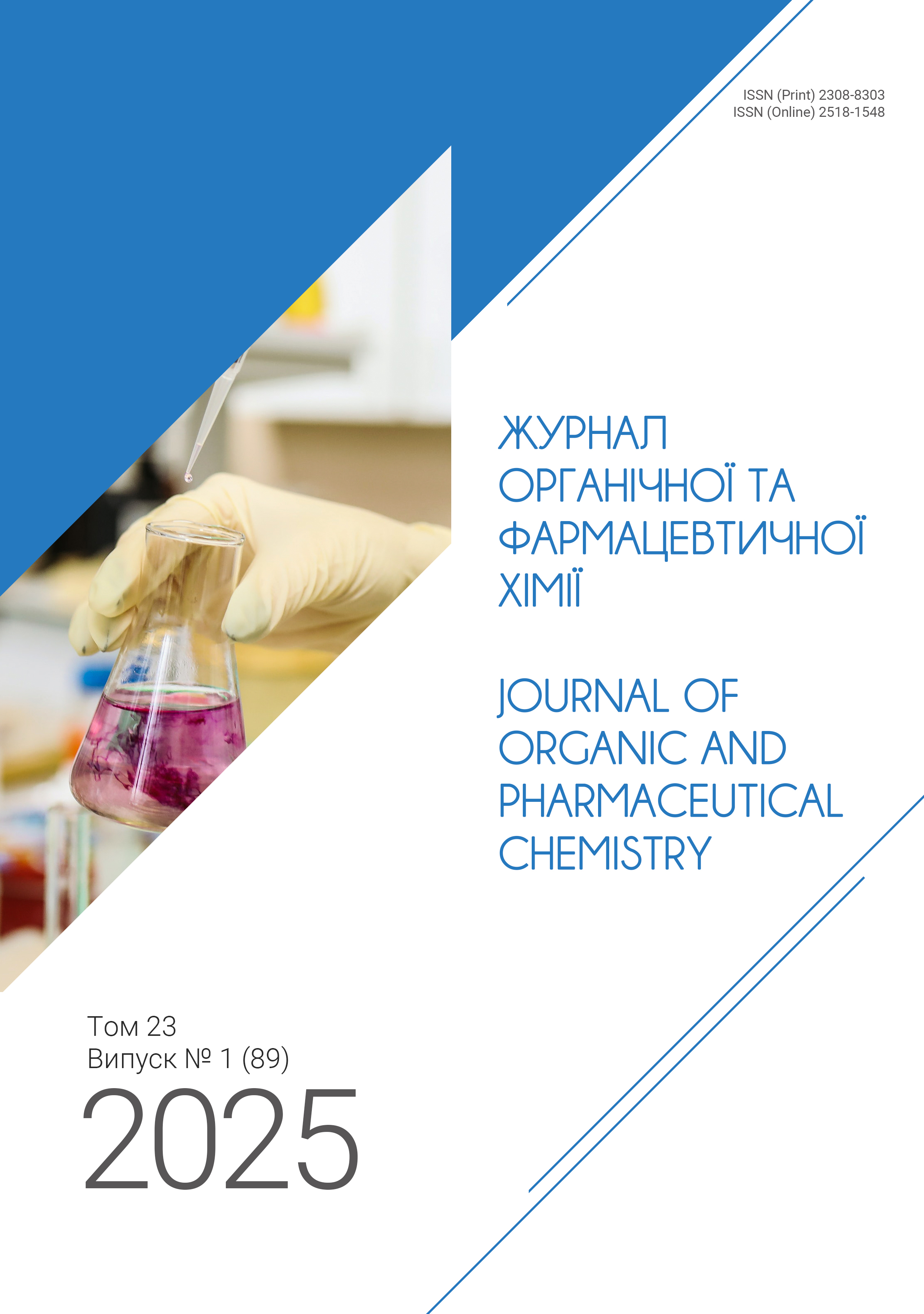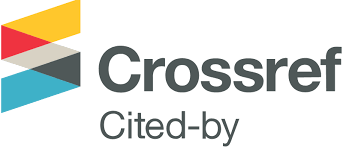An Efficient Synthesis of a Variety of Substituted Pyridine-3-Thiols
DOI:
https://doi.org/10.24959/ophcj.25.324523Keywords:
pyridine, thiols, thiobenzoic acid, chromatography, hydrolysisAbstract
A practical and convenient method for the synthesis of pyridine-3-thiols using substituted 3-iodopyridines as starting compounds has been developed. Based on the use of thiobenzoic acid as a sulfur donor in a two-step procedure, this approach made it possible to synthesize a number of pyridine-3-thiols with F, Cl, Br, CH3, OCH3 substituents at various positions of the pyridine ring. The procedure presented gives high yields of the target products with a purity of 95% and is suitable for synthesis in tens of grams.
Supporting Agency
- The authors received no specific funding for this work.
Downloads
References
- Ahmed, I. A. Major Dietary Interventions for the Management of Liver Disease. In Dietary Interventions in Liver Disease; Elsevier, 2019; pp 205 – 212. https://doi.org/10.1016/B978-0-12-814466-4.00017-3.

- NNakhaee, S.; Mehrpour, O. Niacin. In Encyclopedia of Toxicology; Elsevier, 2024; pp 755 – 761. https://doi.org/10.1016/B978-0-12-824315-2.00113-5.

- Sledge, C. L.; Morgan, B. W. Niacin. In Encyclopedia of Toxicology; Elsevier, 2014; pp 504 – 505. https://doi.org/10.1016/B978-0-12-386454-3.00760-0.

- Wittenberg, R. E.; Wolfman, S. L.; De Biasi, M.; Dani, J. A. Nicotinic Acetylcholine Receptors and Nicotine Addiction: A Brief Introduction. Neuropharmacology 2020, 177, 108256. https://doi.org/10.1016/j.neuropharm.2020.108256.
 |
|  |
| 
- Xiao, C.; Zhou, C.; Jiang, J.; Yin, C. Neural Circuits and Nicotinic Acetylcholine Receptors Mediate the Cholinergic Regulation of Midbrain Dopaminergic Neurons and Nicotine Dependence. Acta Pharmacol. Sin. 2020, 41 (1), 1 – 9. https://doi.org/10.1038/s41401-019-0299-4.
 |
|  |
| 
- Experimental and Clinical Neurotoxicology, 2nd ed.; Spencer, P. S., Schaumburg, H. H., Ludolph, A. C., Eds.; Oxford University Press: New York, 2023.
- Wang, J.-G.; Kario, K.; Lau, T.; Wei, Y. Q.; Park, C. G.; Kim, C. H.; Huang, J.; Zhang, W.; Li, Y.; Yan, P.; Hu, D. Use of Dihydropyridine Calcium Channel Blockers in the Management of Hypertension in Eastern Asians: A Scientific Statement from the Asian Pacific Heart Association. Hypertens. Res. 2011, 34 (4), 423 – 430. https://doi.org/10.1038/hr.2010.259.
 |
|  |
| 
- Ling, Y.; Hao, Z.-Y.; Liang, D.; Zhang, C.-L.; Liu, Y.-F.; Wang, Y. The Expanding Role of Pyridine and Dihydropyridine Scaffolds in Drug Design. DDDT 2021, 15, 4289 – 4338. https://doi.org/10.2147/DDDT.S329547.
 |
|  |
| 
- Zhang, H. New Insights into Huperzine A for the Treatment of Alzheimer’s Disease. Acta Pharmacol. Sin. 2012, 33 (9), 1170 – 1175. https://doi.org/10.1038/aps.2012.128.
 |
|  |
| 
- Huaman, M. A.; Sterling, T. R. Treatment of Latent Tuberculosis Infection – An Update. Clinics in Chest Medicine 2019, 40 (4), 839 – 848. https://doi.org/10.1016/j.ccm.2019.07.008.
 |
|  |
| 
- Thee, S.; Garcia-Prats, A. J.; Donald, P. R.; Hesseling, A. C.; Schaaf, H. S. A Review of the Use of Ethionamide and Prothionamide in Childhood Tuberculosis. Tuberculosis 2016, 97, 126 – 136. https://doi.org/10.1016/j.tube.2015.09.007.
 |
|  |
| 
- Weinstock, J.; Wu, J.; Cao, P.; Kingsbury, W. D.; McDermott, J. L.; Kodrasov, M. P.; McKelvey, D. M.; Suresh Kumar, K. G.; Goldenberg, S. J.; Mattern, M. R.; Nicholson, B. Selective Dual Inhibitors of the Cancer-Related Deubiquitylating Proteases USP7 and USP47. ACS Med. Chem. Lett. 2012, 3 (10), 789–792. https://doi.org/10.1021/ml200276j.
 |
|  |
| 
- Zetterberg, F. R.; MacKinnon, A.; Brimert, T.; Gravelle, L.; Johnsson, R. E.; Kahl-Knutson, B.; Leffler, H.; Nilsson, U. J.; Pedersen, A.; Peterson, K.; Roper, J. A.; Schambye, H.; Slack, R. J.; Tantawi, S. Discovery and Optimization of the First Highly Effective and Orally Available Galectin-3 Inhibitors for Treatment of Fibrotic Disease. J. Med. Chem. 2022, 65 (19), 12626 – 12638. https://doi.org/10.1021/acs.jmedchem.2c00660.
 |
|  |
| 
- Niculescu-Duvaz, D.; Gaulon, C.; Dijkstra, H. P.; Niculescu-Duvaz, I.; Zambon, A.; Ménard, D.; Suijkerbuijk, B. M. J. M.; Nourry, A.; Davies, L.; Manne, H.; Friedlos, F.; Ogilvie, L.; Hedley, D.; Whittaker, S.; Kirk, R.; Gill, A.; Taylor, R. D.; Raynaud, F. I.; Moreno-Farre, J.; Marais, R.; Springer, C. J. Pyridoimidazolones as Novel Potent Inhibitors of V-Raf Murine Sarcoma Viral Oncogene Homologue B1 (BRAF). J. Med. Chem. 2009, 52 (8), 2255 – 2264. https://doi.org/10.1021/jm801509w.
 |
|  |
| 
- Augeri, D. J.; O’Connor, S. J.; Janowick, D.; Szczepankiewicz, B.; Sullivan, G.; Larsen, J.; Kalvin, D.; Cohen, J.; Devine, E.; Zhang, H.; Cherian, S.; Saeed, B.; Ng, S.-C.; Rosenberg, S. Potent and Selective Non-Cysteine-Containing Inhibitors of Protein Farnesyltransferase. J. Med. Chem. 1998, 41 (22), 4288 – 4300. https://doi.org/10.1021/jm980298s.
 |
|  |
| 
- Malwal, S. R.; Chen, L.; Hicks, H.; Qu, F.; Liu, W.; Shillo, A.; Law, W. X.; Zhang, J.; Chandnani, N.; Han, X.; Zheng, Y.; Chen, C.-C.; Guo, R.-T.; AbdelKhalek, A.; Seleem, M. N.; Oldfield, E. Discovery of Lipophilic Bisphosphonates That Target Bacterial Cell Wall and Quinone Biosynthesis. J. Med. Chem. 2019, 62 (5), 2564 – 2581. https://doi.org/10.1021/acs.jmedchem.8b01878.
 |
|  |
| 
- Campillo, D.; Belío, Ú.; Martín, A. New Pt→M (M = Ag or Tl) Complexes Based on Anionic Cyclometalated Pt( ii ) Complexes. Dalton Trans. 2019, 48 (10), 3270–3283. https://doi.org/10.1039/C9DT00121B.
 |
|  |
| 
- Fortuño, C.; Martín, A.; Mastrorilli, P.; Latronico, M.; Petrelli, V.; Todisco, S. Stable Mixed-Valence Diphenylphosphanido Bridged Platinum(II)–Platinum(IV) Complexes. Dalton Trans. 2020, 49 (15), 4935–4955. https://doi.org/10.1039/D0DT00712A.
 |
|  |
| 
- Zabolotna, Y.; Volochnyuk, D. M.; Ryabukhin, S. V.; Horvath, D.; Gavrilenko, K. S.; Marcou, G.; Moroz, Y. S.; Oksiuta, O.; Varnek, A. A Close-up Look at the Chemical Space of Commercially Available Building Blocks for Medicinal Chemistry. J. Chem. Inf. Model. 2022, 62 (9), 2171–2185. https://doi.org/10.1021/acs.jcim.1c00811.
 |
|  |
| 
- Fürst, H.; Heltzig, M.; Göbel, W. Beitrag Zur Darstellung Des Pyridin‐3‐sulfochlorids Und Des Pyridin‐3‐thiols. J. Prakt. Chem. 1967, 36 (3–4), 160–164. https://doi.org/10.1002/prac.19670360306.
- El-Aal, H. A. K. A.; Khalaf, A. A. Design and Diversity-Oriented Synthesis of Benzo- and Pyrido-Annulated Medium-Sized N,S-Heterocycles via Thio-Michael and Friedel-Crafts Approaches. Arkivoc 2019, 2019 (6), 212–227. https://doi.org/10.24820/ark.5550190.p011.048.
 |
| 
- St. Jean, D. J.; Ashton, K. S.; Bartberger, M. D.; Chen, J.; Chmait, S.; Cupples, R.; Galbreath, E.; Helmering, J.; Hong, F.-T.; Jordan, S. R.; Liu, L.; Kunz, R. K.; Michelsen, K.; Nishimura, N.; Pennington, L. D.; Poon, S. F.; Reid, D.; Sivits, G.; Stec, M. M.; Tadesse, S.; Tamayo, N.; Van, G.; Yang, K. C.; Zhang, J.; Norman, M. H.; Fotsch, C.; Lloyd, D. J.; Hale, C. Small Molecule Disruptors of the Glucokinase–Glucokinase Regulatory Protein Interaction: 2. Leveraging Structure-Based Drug Design to Identify Analogues with Improved Pharmacokinetic Profiles. J. Med. Chem. 2014, 57 (2), 325–338. https://doi.org/10.1021/jm4016747.
 |
|  |
| 
- Newman, M. S.; Karnes, H. A. The Conversion of Phenols to Thiophenols via Dialkylthiocarbamates. J. Org. Chem. 1966, 31 (12), 3980–3984. https://doi.org/10.1021/jo01350a023.

- Liu, Y.; Kim, J.; Seo, H.; Park, S.; Chae, J. Copper(II)‐Catalyzed Single‐Step Synthesis of Aryl Thiols from Aryl Halides and 1,2‐Ethanedithiol. Adv. Synth. Catal. 2015, 357 (10), 2205–2212. https://doi.org/10.1002/adsc.201400941.
 |
| 
- Maślankiewicz, A.; Marciniec, K.; Pawlowski, M.; Zajdel, P. From Haloquinolines and Halopyridines to Quinoline- and Pyridinesulfonyl Chlorides and Sulfonamides. Heterocycles 2007, 71 (9), 1975. https://doi.org/10.3987/COM-07-11088.
 |
| 
- Sawada, N.; Itoh, T.; Yasuda, N. Efficient Copper-Catalyzed Coupling of Aryl Iodides and Thiobenzoic Acid. Tetrahedron Lett. 2006, 47 (37), 6595–6597. https://doi.org/10.1016/j.tetlet.2006.07.008.
 |
| 
- Ho, D. K. H.; Chan, L.; Hooper, A.; Brennan, P. E. A General and Mild Two-Step Procedure for the Synthesis of Aryl and Heteroaryl Sulfonamides from the Corresponding Iodides. Tetrahedron Lett. 2011, 52 (7), 820–823. https://doi.org/10.1016/j.tetlet.2010.12.050.
 |
| 
Downloads
Published
How to Cite
Issue
Section
License
Copyright (c) 2025 National University of Pharmacy

This work is licensed under a Creative Commons Attribution 4.0 International License.
Authors publishing their works in the Journal of Organic and Pharmaceutical Chemistry agree with the following terms:
1. Authors retain copyright and grant the journal the right of the first publication of the work under Creative Commons Attribution License allowing everyone to distribute and re-use the published material if proper citation of the original publication is given.
2. Authors are able to enter into separate, additional contractual arrangements for the non-exclusive distribution of the journal’s published version of the work (e.g., post it to an institutional repository or publish it in a book) providing proper citation of the original publication.
3. Authors are permitted and encouraged to post their work online (e.g. in institutional repositories or on authors’ personal websites) prior to and during the submission process, as it can lead to productive exchanges, as well as earlier and greater citation of published work (see The Effect of Open Access).















